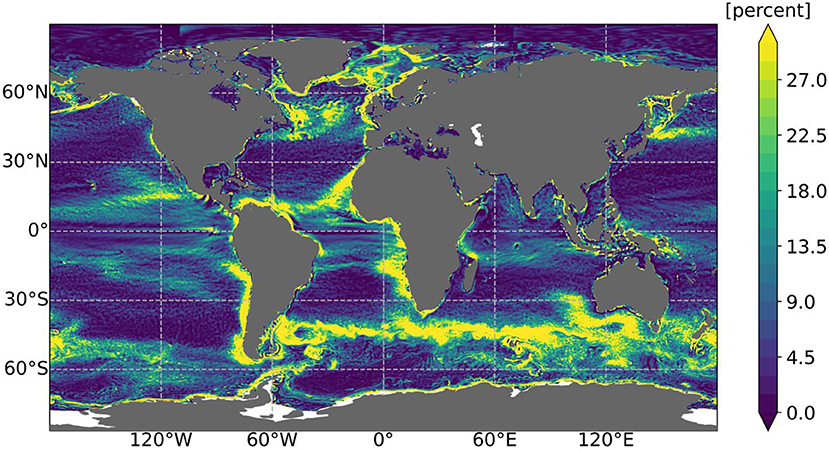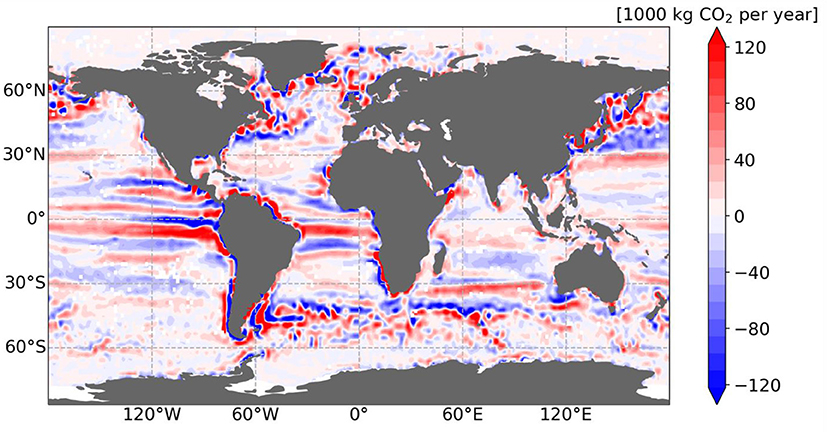Abstract
Carbon dioxide (CO2) is a gas that is important for plants and helps keep our planet warm. Too much CO2 in the air can cause climate change. Small, spinning currents in the ocean, called eddies, play a huge role in moving CO2 between the ocean and the air. These ocean eddies can change the amount of CO2 moving in and out of the ocean by more than 30% in some areas. Depending on how they move through the water, eddies can either help to take carbon dioxide from the air into the ocean or move it out of the ocean into the air. Understanding how ocean eddies work is super important for knowing how the ocean helps manage CO2 and fights climate change. By studying these swirling currents, scientists can better predict how the ocean will respond to a changing climate and how it will continue to support life on Earth.
The Ocean Acts as a Giant Sponge for Carbon Dioxide
The ocean acts as a giant sponge for carbon dioxide (CO2), playing a crucial role in fighting climate change. Every year, the ocean absorbs about 26% of the CO2 released into the air from activities such as burning fossil fuels to make electricity, cutting down forests, and manufacturing cement. This means that the ocean takes in a massive amount of CO2, helping to reduce the greenhouse gases in the air that contribute to global warming. By soaking up this extra CO2, the ocean helps to keep our planet’s climate more stable. Without the ocean’s ability to absorb CO2, climate change would be much more severe, making the ocean’s role in managing carbon dioxide essential for a healthy Earth.
The amount of CO2 that moves back and forth between the air and the ocean changes depending on factors such as changing seawater temperatures. If an ocean region takes in CO2, it is called a carbon sink. If it releases CO2 into the air, it is called a carbon source. Scientists measure this CO2 exchange with electronic sensors, but these measurements are usually taken in small areas. Studies that cover much larger areas of Earth’s oceans often have less detail and can miss out on important processes. This means we might not fully understand how much small changes in the ocean help with CO2 absorption. By learning more about these small changes, we can better understand how the ocean helps keep our planet healthy. Ocean eddies are one cause of these small changes.
What are Ocean Eddies?
Imagine the ocean is like a large bowl of soup. When you blow on the soup, it creates swirling patterns on the surface. Similarly, the wind blows across the ocean, creating small, spinning circles of water called eddies (Figure 1). Eddies in the ocean are often created by the twisting and turning of powerful currents, such as the Gulf Stream, which flows along the U.S. East Coast. When these strong currents meander or waver, they can create a sort of swirling disturbance in the water. Over time, this swirling disturbance can become more pronounced and eventually “break off” from the main current, forming a circular eddy. Although they can be 200 km wide, eddies are considered small compared to the vastness of the global oceans—the Pacific Ocean, for example, is about 20,000 km wide! Eddies move warm water to cold places and cold water to warm places, mixing things up in the ocean. This helps tiny sea creatures and nutrients travel around, making the ocean a healthier place for all the fish and animals that live there. It is like the ocean’s way of stirring its big soup pot, to keep everything balanced and lively!

- Figure 1 - A global map showing swirling currents, called eddies, in the ocean.
- The blue colors represent how strongly the water is spinning, with the darkest blue showing us where the eddies are located.
Eddies Move CO2 Between the Air and Ocean
Scientists are still learning how ocean eddies affect how much CO2 moves between the ocean and the air. It is tricky to study these effects because there are not many measurements available, and studying eddies is complex and computer intensive. Recent research has shown that in some parts of the ocean, eddies are good at pulling CO2 into the ocean [1]. However, scientists are still trying to figure out exactly how eddies influence ocean CO2 absorption as a whole, across all the world’s oceans. There are still lots of questions to answer, like whether eddies make certain areas of the ocean better at capturing CO2 from the air or whether our current studies might be missing important details.
To investigate how eddies affect the exchange of CO2 between the ocean and air, we use a method called coarse-graining [2, 3]. This technique helps us separate eddy features smaller than about 200 km across from larger-scale flows in the ocean, using a super-detailed ocean simulated with a powerful computer [4]. Using this simulated ocean, we can estimate how eddies contribute to air-sea CO2 exchange, as shown in Figure 2. We found some interesting results.

- Figure 2 - A global map showing how eddies affect how much CO2 is exchanged between the air and the ocean.
- The colors tell us what percentage of the differences in air-sea CO2 exchange is caused by eddies in any part of the world’s oceans. For example, you can see that near Japan, in the Southern Ocean near Antarctica, and around the coasts of the United States and Brazil, eddies contribute to more than 25% of CO2 exchange. In some areas, like near the equator, eddies play a smaller role, contributing around 5%. The yellow areas show where eddies strongly affect CO2 exchange, while the dark blue areas show where their effect is smaller.
Eddies make the biggest changes to CO2 exchange in specific ocean regions, like areas near the poles and in the middle latitudes (30–45° latitude north and south) of the ocean where powerful currents meet. In these areas with lots of eddies, eddies are responsible for more than 30% of the variations in how much CO2 is exchanged between the ocean and the atmosphere, influencing whether more CO2 is absorbed or released. On the other hand, in quiet parts of the ocean, eddies hardly affect CO2 exchange at all. This shows us that understanding and studying eddies is really important to better understand how the ocean as a whole absorbs and releases CO2.
How do Eddies Impact Local Carbon Absorption?
Now we know that ocean eddies cause some of the CO2 movement between the ocean and the air. But the big question is whether these swirls help the ocean absorb more CO2 (making the ocean a carbon sink) or release it into the air (making the ocean a carbon source). To figure this out, we analyzed all the oceans and found that, in some places, ocean eddies are helping the ocean absorb CO2.
While in other places the eddies are causing the ocean to release CO2 into the air (Figure 3). Taken altogether, eddies can affect the absorption/release of over 300,000 tons of CO2 every year. That is equivalent to the amount of CO2 that would be released by 30,000 car trips around the earth! This shows that the influence of these small ocean swirls on air-sea CO2 exchange is large and can be very different from place to place in the ocean.

- Figure 3 - A global map showing how eddies affect the amount of CO2 that the ocean absorbs or releases.
- Blue colors indicate where eddies help the ocean absorb CO2, while red colors show where eddies help to release CO2 from the ocean into the air. The darker the color, the more CO2 is absorbed or released.
The ocean becomes a carbon source or a carbon sink because of how ocean eddies twist and turn in different ways. We found that if an eddy is spinning in a way that brings water with more CO2 to a part of the ocean with less CO2, the receiving part will get too much CO2 and release it into the air. But if the eddy spins the other way, bringing water with less CO2 to an area that does not have much CO2, the ocean absorbs more CO2 from the air. In short, the spinning of ocean eddies sets whether the ocean is a carbon source or sink, and these changes in different parts of the ocean.
As the ocean gets warmer due to global warming, scientists think that eddies might become even more active and important in influencing how CO2 moves between the ocean and the air [5]. For example, with more heatwaves in the ocean, higher ocean temperatures might make the swirling currents work differently, which could affect how much CO2 gets moved around. To understand this better, scientists need to monitor the ocean more closely and improve their computer models to predict how eddies will influence our climate. Knowing more about ocean eddies will help us plan better ways to protect our planet from climate change.
Glossary
Carbon Sink: ↑ An ocean area that absorbs and stores carbon dioxide from the air.
Carbon Source: ↑ An ocean area that releases carbon dioxide (CO2) into the air.
Eddies: ↑ Small, spinning currents in the ocean, like mini whirlpools, that moves water and nutrients around.
Gulf Stream: ↑ A strong, warm ocean current in the Atlantic Ocean that flows from the Gulf of Mexico along the eastern coast of the United States and across the Atlantic to Europe.
Coarse-graining: ↑ A method to look at the big picture by combining smaller details into larger groups.
Air-Sea CO2 Exchange: ↑ The process by which CO2 moves between the ocean and the air, helping to control the amount of CO2 in the atmosphere, which influences climate change.
Conflict of Interest
The authors declare that the research was conducted in the absence of any commercial or financial relationships that could be construed as a potential conflict of interest.
Acknowledgments
YG and M-LT were supported by the Yale Center for Natural Carbon Capture. The authors thank Elizabeth Grant for her valuable feedback, which improved this manuscript. Support for this research was provided by the Yale Center for Natural Carbon Capture. We would like to acknowledge high performance computing support from Cheyenne and Casper supercomputers provided by National Center for Atmospheric Research’s Computational and Information Systems Laboratory, sponsored by the National Science Foundation.
Original Source Article
↑Guo, Y., and Timmermans, M.-L. (2024). The role of ocean mesoscale variability in air-sea CO2 exchange: a global perspective. Geophys. Res. Lett. 51:e2024GL108373. doi: 10.1029/2024GL108373
References
[1] ↑ Ford, D. J., Tilstone, G. H., Shutler, J. D., Kitidis, V., Sheen, K. L., Dall'Olmo, G., et al. 2023. Mesoscale eddies enhance the air-sea CO2 sink in the South Atlantic Ocean. Geophys. Res. Lett. 50:e2022GL102137. doi: 10.1029/2022GL102137
[2] ↑ Guo, Y., and Timmermans, M. L. 2024. The role of ocean mesoscale variability in air-sea CO2 exchange: a global perspective. Geophys. Res. Lett. 51:e2024GL108373. doi: 10.1029/2024GL108373
[3] ↑ Storer, B. A., and Aluie, H. 2023. FlowSieve: a coarse-graining utility for geophysical flows on the sphere. J. Open Source Softw. 8:4277. doi: 10.21105/joss.04277
[4] ↑ Guo, Y., and Timmermans, M. L. 2024. Global ocean pCO2 variation regimes: spatial patterns and the emergence of a hybrid regime. J. Geophys. Res.: Oceans 129:e2023JC020679. doi: 10.1029/2023JC020679
[5] ↑ Guo, Y., Bachman, S., Bryan, F., and Bishop, S. Increasing trends in oceanic surface poleward eddy heat flux observed over the past three decades. Geophys. Res. Lett. 49:e2022GL099362. doi: 10.1029/2022GL099362
